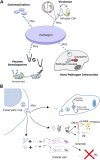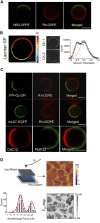The Emerging World of Membrane Vesicles: Functional Relevance, Theranostic Avenues and Tools for Investigating Membrane Function
- PMID: 33968983
- PMCID: PMC8101706
- DOI: 10.3389/fmolb.2021.640355
The Emerging World of Membrane Vesicles: Functional Relevance, Theranostic Avenues and Tools for Investigating Membrane Function
Abstract
Lipids are essential components of cell membranes and govern various membrane functions. Lipid organization within membrane plane dictates recruitment of specific proteins and lipids into distinct nanoclusters that initiate cellular signaling while modulating protein and lipid functions. In addition, one of the most versatile function of lipids is the formation of diverse lipid membrane vesicles for regulating various cellular processes including intracellular trafficking of molecular cargo. In this review, we focus on the various kinds of membrane vesicles in eukaryotes and bacteria, their biogenesis, and their multifaceted functional roles in cellular communication, host-pathogen interactions and biotechnological applications. We elaborate on how their distinct lipid composition of membrane vesicles compared to parent cells enables early and non-invasive diagnosis of cancer and tuberculosis, while inspiring vaccine development and drug delivery platforms. Finally, we discuss the use of membrane vesicles as excellent tools for investigating membrane lateral organization and protein sorting, which is otherwise challenging but extremely crucial for normal cellular functioning. We present current limitations in this field and how the same could be addressed to propel a fundamental and technology-oriented future for extracellular membrane vesicles.
Keywords: diagnosis; drug delivery; exosomes; host-pathogen interactions; lipid biomarkers; lipids; membrane organization; membrane vesicles.
Copyright © 2021 Srivatsav and Kapoor.
Conflict of interest statement
The authors declare that the research was conducted in the absence of any commercial or financial relationships that could be construed as a potential conflict of interest.
Figures




Similar articles
-
Biogenesis, Membrane Trafficking, Functions, and Next Generation Nanotherapeutics Medicine of Extracellular Vesicles.Int J Nanomedicine. 2021 May 18;16:3357-3383. doi: 10.2147/IJN.S310357. eCollection 2021. Int J Nanomedicine. 2021. PMID: 34040369 Free PMC article. Review.
-
Exosomal lipids from membrane organization to biomarkers: Focus on an endolysosomal-specific lipid.Biochimie. 2022 Dec;203:77-92. doi: 10.1016/j.biochi.2022.09.016. Epub 2022 Sep 30. Biochimie. 2022. PMID: 36184001 Review.
-
Role of lipid signalling in extracellular vesicles-mediated cell-to-cell communication.Cytokine Growth Factor Rev. 2023 Oct;73:20-26. doi: 10.1016/j.cytogfr.2023.08.006. Epub 2023 Aug 23. Cytokine Growth Factor Rev. 2023. PMID: 37648617 Review.
-
An emerging focus on lipids in extracellular vesicles.Adv Drug Deliv Rev. 2020;159:308-321. doi: 10.1016/j.addr.2020.03.002. Epub 2020 Mar 7. Adv Drug Deliv Rev. 2020. PMID: 32151658 Review.
-
Changes in lipid composition of host-derived extracellular vesicles following Salmonella infection.Microbiol Spectr. 2024 Jan 11;12(1):e0279623. doi: 10.1128/spectrum.02796-23. Epub 2023 Dec 11. Microbiol Spectr. 2024. PMID: 38078720 Free PMC article.
Cited by
-
Potential of Mesenchymal Stromal Cell-Derived Extracellular Vesicles as Natural Nanocarriers: Concise Review.Pharmaceutics. 2023 Feb 7;15(2):558. doi: 10.3390/pharmaceutics15020558. Pharmaceutics. 2023. PMID: 36839879 Free PMC article. Review.
-
Stem Cell-Derived Exosomes Potential Therapeutic Roles in Cardiovascular Diseases.Front Cardiovasc Med. 2021 Aug 10;8:723236. doi: 10.3389/fcvm.2021.723236. eCollection 2021. Front Cardiovasc Med. 2021. PMID: 34447796 Free PMC article. Review.
-
The role of antibiotic-derived mycobacterial vesicles in tuberculosis pathogenesis.Sci Rep. 2024 Nov 15;14(1):28198. doi: 10.1038/s41598-024-79215-3. Sci Rep. 2024. PMID: 39548211 Free PMC article.
-
Adaptations of Bacterial Extracellular Vesicles in Response to Antibiotic Pressure.Int J Mol Sci. 2025 May 23;26(11):5025. doi: 10.3390/ijms26115025. Int J Mol Sci. 2025. PMID: 40507835 Free PMC article. Review.
-
Tumor-Derived Membrane Vesicles: A Promising Tool for Personalized Immunotherapy.Pharmaceuticals (Basel). 2022 Jul 16;15(7):876. doi: 10.3390/ph15070876. Pharmaceuticals (Basel). 2022. PMID: 35890175 Free PMC article. Review.
References
-
- Abramowicz A., Wojakowska A., Marczak L., Lysek-Gladysinska M., Smolarz M., Story M. D., et al. (2019). Ionizing radiation affects the composition of the proteome of extracellular vesicles released by head-and-neck cancer cells in vitro . J. Radiat. Res. 60 (3), 289–297. 10.1093/jrr/rrz001 - DOI - PMC - PubMed
-
- Akuma P., Okagu O. D., Udenigwe C. C. (2019). Naturally occurring exosome vesicles as potential delivery vehicle for bioactive compounds. Front. Sustain. Food Syst. 3. 10.3389/fsufs.2019.00023 - DOI
-
- Alaniz R. C., Deatherage B. L., Lara J. C., Cookson B. T. (2007). Membrane vesicles are immunogenic facsimiles of Salmonella typhimurium that potently activate dendritic cells, prime B and T cell responses, and stimulate protective immunity in vivo. J. Immunol. 179, 7692–7701. 10.4049/jimmunol.179.11.7692 - DOI - PubMed
Publication types
LinkOut - more resources
Full Text Sources
Other Literature Sources

